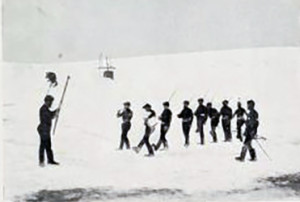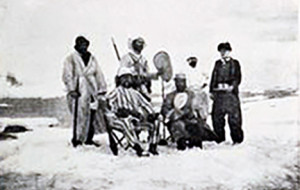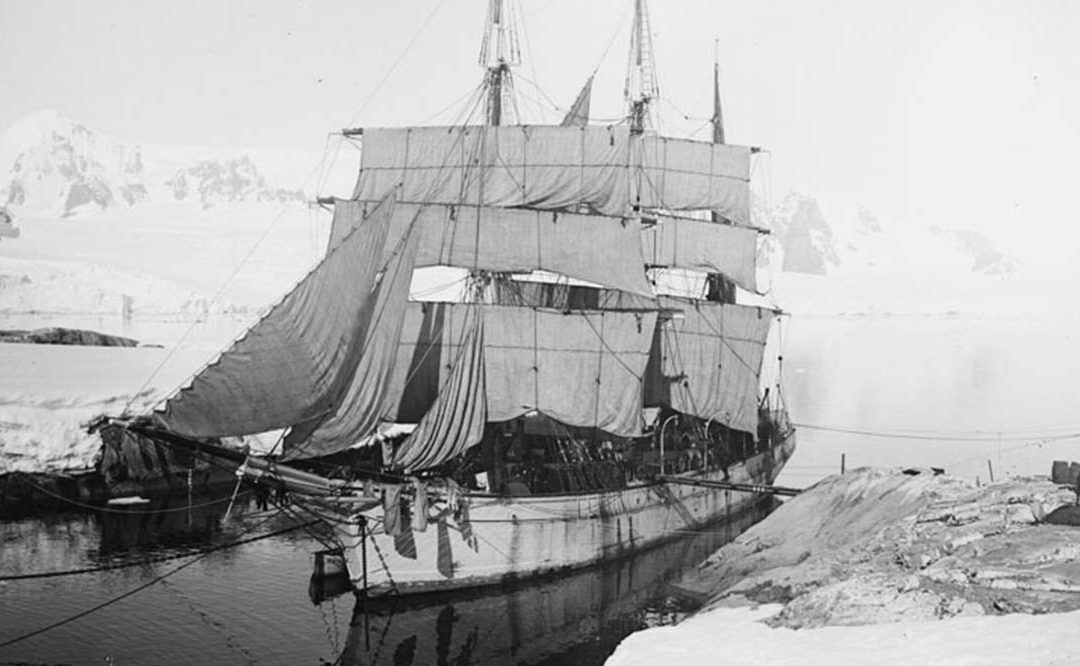Charcot, Doctor of Medicine, and polar explorer picnicked twice in Antarctica. Each time, he used the situation to divert his crew from the boredom of being ice-bound.
Charcot does not mention what they ate or drank in 1904 but uncharacteristically notes the episode is a picnic instead of pique-nique. Afterall, it wasn’t a déjeuner sur l’herbe or partie de campagne. Amusingly when the crew raised their spirits by singing, they were accompanied by a chorus of barking dogs.

“Shrove Tuesday parade.” Journal of the Second French South Polar Expedition, 1908-1910.
Five years later, he and the crew of the Pourquoi Pas? ate traditional crêpes and drank wine to honor Mardi Gras.

Journal of the Second French South Polar Expedition, 1908-1910.
It was a spontaneous celebration of Mardi Gras because the weather was good, and Charcot meticulously recorded the fun in his journal:
“February 23, Shrove Tuesday. — Without troubling about the Carnival, the men have been at work since morning, and under the direction of Gourdon, are stacking on land the cases of provisions. At lunchtime, Liouville appears with his beard shaved off, wearing Austrian whiskers, with his nose painted red and his head covered with a tropical helmet. Then Gourdon and Gain disguise themselves in their turn, showing a strong preference for white clothes and tropical headgear. The mess steward turns out in a most extraordinary garb, and the cook is disguised as the chef in a big hotel. This is the signal for a general masquerade, very merry, though simple. The crew are content with turning up their trouser-legs and displaying superb red under-clothing, which, with their blue knitted vests and sealers’ boots and caps, makes a lovely uniform. Bongrain adds to his already respectable height by adorning his head-dress with the only feather on board, and carries in his hand an enormous pole. Then everyone gets hold of a gun, and the troop goes through evolutions on the island, while Liouville uses a clarinet as a bugle and Lerebourg accompanies him on a tin box as a drum, and Gourdon, harnessed to a sledge, represents the ambulance service. The greatest merriment prevails, and the rest of the day is treated as a holiday. In spite of the north-east wind, we have been spared snow in the afternoon, but in the evening, it begins to fall again, so that we do not lack confetti, fortunately clean. Dinner includes pancakes, well washed down, and Gourdon brings out of the hold a tin box, labeled ‘For Shrove Tuesday,’ containing some excellent honey, which a member of his family kindly presented before we started from home.”
This picnic ended when the weather shifted. The picnic joy evaporated in a storm that Charcot wrote is “worse than it has ever been.”
Le Pourquoi pas? wrecked in a gale on a reef near Iceland in 1936, and Charcot drowned. Almost fifty years later, divers found a bottle of red Boudreaux in the wreckage. Nice touch, if true.
See: Jean-Baptiste Charcot Journal de l’expédition Antarctique Française, 1903-1905. Le “Français” au Pôle sud, Paris: Ernest Flammarion, 1906; Jean-Baptiste Charcot. Le Pourquoi Pas ? dans L’Anatarctic, 1908-1910 ;http://books.google.com/books?id=mboEAAAAYAAJ&q=may+30#v=onepage&q=%2030%20mai%20&f=false; Le Pourquoi Pas ? dans L’Anatarctic 1908-1910. (Paris: Ernest Flammarion, 1910); The Voyage of the Why Not? In the Antarctic. Translated by Philip Walsh (New York: Hodder and Stoughton, 1911)

